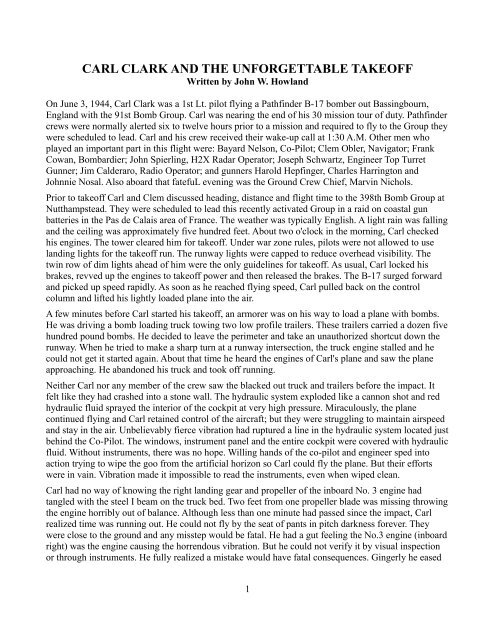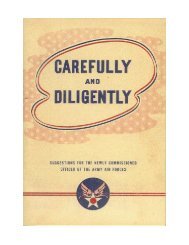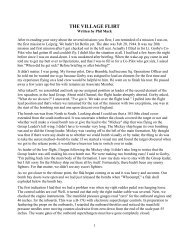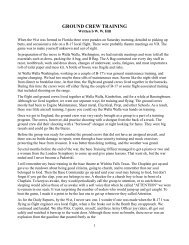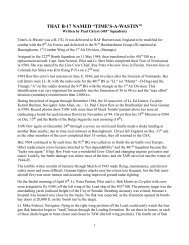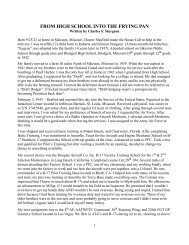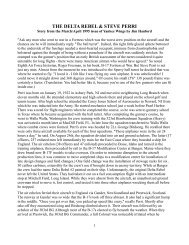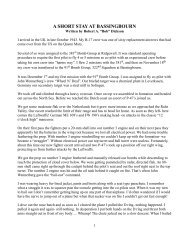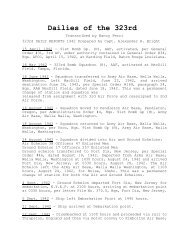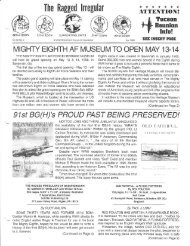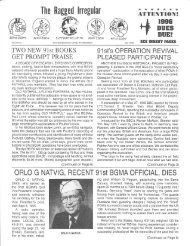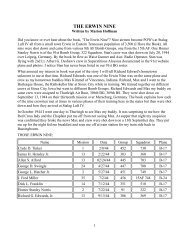CARL CLARK AND THE UNFORGETTABLE ... - the 91st Bomb Group!
CARL CLARK AND THE UNFORGETTABLE ... - the 91st Bomb Group!
CARL CLARK AND THE UNFORGETTABLE ... - the 91st Bomb Group!
You also want an ePaper? Increase the reach of your titles
YUMPU automatically turns print PDFs into web optimized ePapers that Google loves.
<strong>CARL</strong> <strong>CLARK</strong> <strong>AND</strong> <strong>THE</strong> <strong>UNFORGETTABLE</strong> TAKEOFF<br />
Written by John W. Howland<br />
On June 3, 1944, Carl Clark was a 1st Lt. pilot flying a Pathfinder B-17 bomber out Bassingbourn,<br />
England with <strong>the</strong> <strong>91st</strong> <strong>Bomb</strong> <strong>Group</strong>. Carl was nearing <strong>the</strong> end of his 30 mission tour of duty. Pathfinder<br />
crews were normally alerted six to twelve hours prior to a mission and required to fly to <strong>the</strong> <strong>Group</strong> <strong>the</strong>y<br />
were scheduled to lead. Carl and his crew received <strong>the</strong>ir wake-up call at 1:30 A.M. O<strong>the</strong>r men who<br />
played an important part in this flight were: Bayard Nelson, Co-Pilot; Clem Obler, Navigator; Frank<br />
Cowan, <strong>Bomb</strong>ardier; John Spierling, H2X Radar Operator; Joseph Schwartz, Engineer Top Turret<br />
Gunner; Jim Calderaro, Radio Operator; and gunners Harold Hepfinger, Charles Harrington and<br />
Johnnie Nosal. Also aboard that fatefuL evening was <strong>the</strong> Ground Crew Chief, Marvin Nichols.<br />
Prior to takeoff Carl and Clem discussed heading, distance and flight time to <strong>the</strong> 398th <strong>Bomb</strong> <strong>Group</strong> at<br />
Nutthampstead. They were scheduled to lead this recently activated <strong>Group</strong> in a raid on coastal gun<br />
batteries in <strong>the</strong> Pas de Calais area of France. The wea<strong>the</strong>r was typically English. A light rain was falling<br />
and <strong>the</strong> ceiling was approximately five hundred feet. About two o'clock in <strong>the</strong> morning, Carl checked<br />
his engines. The tower cleared him for takeoff. Under war zone rules, pilots were not allowed to use<br />
landing lights for <strong>the</strong> takeoff run. The runway lights were capped to reduce overhead visibility. The<br />
twin row of dim lights ahead of him were <strong>the</strong> only guidelines for takeoff. As usual, Carl locked his<br />
brakes, revved up <strong>the</strong> engines to takeoff power and <strong>the</strong>n released <strong>the</strong> brakes. The B-17 surged forward<br />
and picked up speed rapidly. As soon as he reached flying speed, Carl pulled back on <strong>the</strong> control<br />
column and lifted his lightly loaded plane into <strong>the</strong> air.<br />
A few minutes before Carl started his takeoff, an armorer was on his way to load a plane with bombs.<br />
He was driving a bomb loading truck towing two low profile trailers. These trailers carried a dozen five<br />
hundred pound bombs. He decided to leave <strong>the</strong> perimeter and take an unauthorized shortcut down <strong>the</strong><br />
runway. When he tried to make a sharp turn at a runway intersection, <strong>the</strong> truck engine stalled and he<br />
could not get it started again. About that time he heard <strong>the</strong> engines of Carl's plane and saw <strong>the</strong> plane<br />
approaching. He abandoned his truck and took off running.<br />
Nei<strong>the</strong>r Carl nor any member of <strong>the</strong> crew saw <strong>the</strong> blacked out truck and trailers before <strong>the</strong> impact. It<br />
felt like <strong>the</strong>y had crashed into a stone wall. The hydraulic system exploded like a cannon shot and red<br />
hydraulic fluid sprayed <strong>the</strong> interior of <strong>the</strong> cockpit at very high pressure. Miraculously, <strong>the</strong> plane<br />
continued flying and Carl retained control of <strong>the</strong> aircraft; but <strong>the</strong>y were struggling to maintain airspeed<br />
and stay in <strong>the</strong> air. Unbelievably fierce vibration had ruptured a line in <strong>the</strong> hydraulic system located just<br />
behind <strong>the</strong> Co-Pilot. The windows, instrument panel and <strong>the</strong> entire cockpit were covered with hydraulic<br />
fluid. Without instruments, <strong>the</strong>re was no hope. Willing hands of <strong>the</strong> co-pilot and engineer sped into<br />
action trying to wipe <strong>the</strong> goo from <strong>the</strong> artificial horizon so Carl could fly <strong>the</strong> plane. But <strong>the</strong>ir efforts<br />
were in vain. Vibration made it impossible to read <strong>the</strong> instruments, even when wiped clean.<br />
Carl had no way of knowing <strong>the</strong> right landing gear and propeller of <strong>the</strong> inboard No. 3 engine had<br />
tangled with <strong>the</strong> steel I beam on <strong>the</strong> truck bed. Two feet from one propeller blade was missing throwing<br />
<strong>the</strong> engine horribly out of balance. Although less than one minute had passed since <strong>the</strong> impact, Carl<br />
realized time was running out. He could not fly by <strong>the</strong> seat of pants in pitch darkness forever. They<br />
were close to <strong>the</strong> ground and any misstep would be fatal. He had a gut feeling <strong>the</strong> No.3 engine (inboard<br />
right) was <strong>the</strong> engine causing <strong>the</strong> horrendous vibration. But he could not verify it by visual inspection<br />
or through instruments. He fully realized a mistake would have fatal consequences. Gingerly he eased<br />
1
ack on power to <strong>the</strong> No. 3 engine. The vibration lessened. Again he reduced power to Number 3, and<br />
again vibration diminished. The instrument panel came into focus. Confident he had found <strong>the</strong> culprit;<br />
he fea<strong>the</strong>red <strong>the</strong> prop and killed <strong>the</strong> No. 3 engine while eager hands finished cleaning up <strong>the</strong> instrument<br />
panel. Carl gained visual access to all his instruments. The immediate crisis was over and he climbed<br />
for altitude on <strong>the</strong> fully functional three remaining engines. He reported to <strong>the</strong> base by radio that "he<br />
had hit something on <strong>the</strong> runway, lost an engine, and <strong>the</strong> cockpit was smeared with red hydraulic fluid.<br />
All on board were safe." He <strong>the</strong>n asked, "What did we run into?" The tower reported, "We don't know<br />
right now, but we'll sure find out." The base commander was <strong>the</strong>n notified of <strong>the</strong> accident. He drove to<br />
<strong>the</strong> Control Tower and immediately dispatched a second PFF crew to <strong>the</strong> 398th BG at Nutthampstead.<br />
Shortly before 2:30 A.M. an orderly awakened me. It was <strong>the</strong> same orderly who had awakened my<br />
roommate and Navigator colleague Clem Obler about an hour earlier. "Lt. Howland", he called. "Get<br />
up! Lt. Obler and his crew crashed on takeoff and you will have to fly his mission." In an emotional<br />
outburst brought on by gut-tearing apprehension I yelled at <strong>the</strong> orderly, "What happened? Tell me what<br />
happened!"<br />
The excited orderly replied, "A bomb truck and trailer stalled in <strong>the</strong> center of <strong>the</strong> runway while <strong>the</strong>y<br />
were taking off. They barely got <strong>the</strong> plane in <strong>the</strong> air before <strong>the</strong>y collided. Number three engine was<br />
knocked out; but <strong>the</strong>y managed to stay airborne."<br />
Greatly relieved to hear that Carl Clark was able to get <strong>the</strong> plane into <strong>the</strong> air, I reached for my clo<strong>the</strong>s<br />
and started dressing. I was still worried about Clem who, like me, always rides in <strong>the</strong> nose of <strong>the</strong> ship at<br />
takeoff. By <strong>the</strong> time I reached <strong>the</strong> flight line, Clark had radioed back that all on board were safe. My<br />
pilot, Jim Tyson, and I desperately wanted to stay in Bassingbourn and see our friends down safely.<br />
However, <strong>the</strong> mission to Pas de Calais was our first priority of business. We took off in a drizzling rain<br />
bound for <strong>the</strong> 398th <strong>Bomb</strong> <strong>Group</strong> at Nutthampstead shortly before 0300 hours. Meantime, Col. Henry<br />
Terry took charge of recovery operations working directly with Carl Clark. He instructed Carl to circle<br />
within radio range while <strong>the</strong>y evaluated damage to <strong>the</strong> aircraft and planned a course of action. For Carl,<br />
it was comforting to see <strong>the</strong> clear air and star-filled sky above <strong>the</strong> layer of solid clouds. However,<br />
comfort gave way to dismay when he was ordered to descend through <strong>the</strong> clouds and make an<br />
overflight of <strong>the</strong> tower. An evaluation of damage to <strong>the</strong> aircraft was made using a powerful searchlight.<br />
Ground observers could see <strong>the</strong> broken drag link and <strong>the</strong> dangling, useless right undercarriage. Carl<br />
was instructed to climb above <strong>the</strong> clouds and continue circling within range of <strong>the</strong> tower radio.<br />
"Evening Folks - How Y'all" was <strong>the</strong> name of Clark's PFF bomber. The phrase w as a trademark of <strong>the</strong><br />
popular bandleader Kay Kyser and assigned by a nephew of Kyser who first flew <strong>the</strong> airplane. Marvin<br />
Nichols was <strong>the</strong> 324th <strong>Bomb</strong> Squadron Ground Crew Chief responsible for maintaining "Evening<br />
Folks - How Y'all" in tip- top flying condition. Normally, Marvin did not fly with a combat crew; but<br />
this mission was different. Carl Clark was scheduled to fly to <strong>the</strong> recently activated 398th <strong>Bomb</strong> <strong>Group</strong><br />
at Nutthampstead where his aircraft was to be loaded with bombs. Fuses would <strong>the</strong>n be installed.<br />
Marvin Nichols didn't leave anything to chance regarding his plane and decided to go along with Carl<br />
and double check performance of <strong>the</strong> Nutthampstead ground crew. He would personally run a final<br />
check on <strong>the</strong> engines prior to takeoff for <strong>the</strong> mission. Of course, Marvin had his tool kit on board.<br />
Carl had done a masterful job getting <strong>the</strong> plane into <strong>the</strong> air. When <strong>the</strong>y were once again above <strong>the</strong><br />
clouds and relatively safe, <strong>the</strong> second key player in this drama went into action. Marvin determined<br />
severe vibration had ruptured a line in <strong>the</strong> hydraulic system. The broken line was directly behind <strong>the</strong><br />
co-pilot's seat. A replacement section might make <strong>the</strong> system functional again. This would require<br />
careful cutting, shaping and fitting. However, Marvin was optimistic. He told Carl <strong>the</strong>re was a fairly<br />
good chance <strong>the</strong> hydraulic brakes in <strong>the</strong> left main landing gear could be restored. Carl relayed this<br />
2
information back to base by radio.<br />
Under normal conditions a crew flying a damaged B-17 would be instructed to put it on auto pilot, head<br />
out over <strong>the</strong> North Sea, and bail out before leaving <strong>the</strong> coast of England. However, Carl's plane was<br />
special. His was a Pathfinder Force plane and contained one of <strong>the</strong> precious H2X radar systems so<br />
desperately needed at that time. Carl reported Marvin's observation, and <strong>the</strong> decision was made. Carl<br />
was ordered to fly around for approximately nine hours to use up all excess gasoline while Marvin<br />
attempted to restore <strong>the</strong> braking system for <strong>the</strong> left main landing gear. Providing Marvin's efforts were<br />
successful, Carl would <strong>the</strong>n come in for a one-wheel landing. The landing would require full use of <strong>the</strong><br />
left brake to slow <strong>the</strong> plane down after landing. This would cause <strong>the</strong> plane to veer to <strong>the</strong> left. However,<br />
<strong>the</strong> drag link was broken and <strong>the</strong> useless right landing gear was dangling. All concerned hoped it would<br />
provide some braking action as it tore up <strong>the</strong> landscape; but no one involved had ever used a torn-up<br />
landing gear as a brake. There was some concern that <strong>the</strong> landing gear struts would "dig-in" and cause a<br />
devastating high-speed ground loop. Indeed, <strong>the</strong>re were many unknowns. All agreed that after<br />
touchdown, Carl would have to perform a delicate balance act requiring:<br />
1. Application of hydraulic braking power in <strong>the</strong> left wheel to slow down.<br />
2. Application of power to <strong>the</strong> No. 4 engine (outboard right) this would provide added right-side thrust<br />
to counteract drag of <strong>the</strong> damaged right landing gear. The increased flow of air over <strong>the</strong> right wing and<br />
aileron would also provide additional lift and improve <strong>the</strong> effectiveness of aileron control.<br />
3. Judicious application of left aileron to keep <strong>the</strong> right wing high. This would prevent <strong>the</strong> damaged<br />
landing gear from "digging-in" and causing a disastrous high-speed ground loop. However, it was<br />
hoped that braking effect of <strong>the</strong> dangling and skidding right gear would help offset and counteract<br />
hydraulic braking with <strong>the</strong> left main landing gear.<br />
It was now up to Marvin Nichols. If he could not restore hydraulic braking power, <strong>the</strong>y would have to<br />
abandon <strong>the</strong> aircraft. A groundloop at 85 to 90 mph could be deadly. Marvin went to work with his<br />
wonderful bag of tools. He successfully fitted a replacement section using <strong>the</strong> hydraulic fittings and<br />
tools he had brought on board. About 8 o'clock in <strong>the</strong> morning he advised Carl, "I think we have brakes<br />
in that left wheel." Carl pressed <strong>the</strong> toe brake and agreed it felt normal; but he was puzzled. "Marvin,"<br />
he said, "I can understand you having spare fittings and tools to repair <strong>the</strong> hydraulic lines. But how did<br />
you come up with enough hydraulic fluid to replace that which was sprayed all over <strong>the</strong> cockpit?"<br />
Marvin merely smiled and said, "The crew provided enough urine to fill <strong>the</strong> hydraulic tank." Carl<br />
laughed and said; "Will it work?" Marvin nodded his head in agreement and said, "Of Course. Just<br />
don't fly so high that it cools off and freezes."<br />
It was almost eleven o'clock in <strong>the</strong> morning. They had been flying nine hours. Carl gave all<br />
crewmembers <strong>the</strong> option of bailing out over <strong>the</strong> base or staying with <strong>the</strong> plane for a one-wheel crash<br />
landing. However, <strong>the</strong> date was June 3rd and Invasion Fever was in <strong>the</strong> air. One day earlier base<br />
personnel were ordered to wear <strong>the</strong>ir sidearms in case of pre-emptive strikes by German paratroopers.<br />
Parachuting unannounced through <strong>the</strong> clouds into an airbase full of "gun-toting, trigger happy flyboys"<br />
could be extremely hazardous to your health. All crewmembers decided it was much safer to stay with<br />
<strong>the</strong> plane.<br />
A light rain was falling as Carl made his final approach for <strong>the</strong> landing. He lined up so <strong>the</strong> left wheel<br />
rolled on <strong>the</strong> edge of <strong>the</strong> runway while <strong>the</strong> useless right undercarriage dangled over <strong>the</strong> grassy field.<br />
The right wing was held high at <strong>the</strong> moment of touchdown. Carl reduced power and <strong>the</strong> plane started to<br />
slow. A touch of <strong>the</strong> toe brake indicated he indeed had stopping power in <strong>the</strong> left wheel and <strong>the</strong> plane<br />
tended to veer to <strong>the</strong> left. Carefully, Carl lowered <strong>the</strong> right wing and felt drag as <strong>the</strong> damaged gear tore<br />
3
up <strong>the</strong> grassy tarmac. He killed all power to <strong>the</strong> left side engines (Nos. 1 and 2). Judiciously, Carl<br />
applied power through <strong>the</strong> No. 4 (outboard right) engine to provide thrust, airflow and additional lift<br />
over <strong>the</strong> right wing and aileron.<br />
Power applied to <strong>the</strong> No. 4 engine proved to be <strong>the</strong> critical factor in this emergency landing. There was<br />
so much right-side drag; Carl was able to apply full braking power in <strong>the</strong> left wheel. The severe braking<br />
effect of <strong>the</strong> damaged right undercarriage was counteracted by thrust power applied through <strong>the</strong> No. 4<br />
engine. Aileron control kept <strong>the</strong> right wing from dropping and causing a ground loop at high speed. As<br />
<strong>the</strong> plane continued to decelerate, airflow over <strong>the</strong> wing and rudder diminished. Carl continued <strong>the</strong><br />
delicate balance act of braking with <strong>the</strong> left wheel, applying power through <strong>the</strong> No. 4 engine, and<br />
plowing <strong>the</strong> infield with <strong>the</strong> right landing gear. Ultimately, <strong>the</strong>y slowed to approximately 45 MPH. At<br />
that relatively slow speed, even with full left aileron, <strong>the</strong> right wing dropped. The badly abused right<br />
landing gear pulled loose and sheared off half of <strong>the</strong> right horizontal stabilizer. But <strong>the</strong>y were done with<br />
flying. Carl killed power to <strong>the</strong> No. 4 engine and <strong>the</strong> plane did a gentle, non-destructive ground loop<br />
onto <strong>the</strong> grassy tarmac. No one on board was injured. The valuable H2X radar was undamaged.<br />
Carl and <strong>the</strong> crew were <strong>the</strong>n greeted by Col. Henry Terry, Commanding Officer of <strong>the</strong> <strong>91st</strong> <strong>Bomb</strong><br />
<strong>Group</strong>. Carl was promoted from 1st Lt. to Captain on <strong>the</strong> spot and later awarded <strong>the</strong> Distinguished<br />
Flying Cross for his performance. He was also ordered back into action. The following day he and his<br />
crew were directed to lead a 1st Combat Wing attack on German targets in <strong>the</strong> Pas de Calais area of<br />
France. Evidently <strong>the</strong>re was some high-level concern about <strong>the</strong> trauma associated with <strong>the</strong>ir narrow<br />
escape. My PFF crew (Jim Tyson pilot) was sent along to fly as deputy lead for our close friends and<br />
associates. They did a first rate job leading our attack on coastal defenses in <strong>the</strong> Pas de Calais area. Two<br />
days later, on D-Day, June 6, 1944, Carl Clark led a <strong>Group</strong> of 18 bombers in a successful visual attack<br />
on an enemy Airport at St.Lo. My crew led a separate <strong>Group</strong> of eighteen bombers making a "through<br />
<strong>the</strong> clouds" attack on Gold Beach coastal batteries north of Bayeaux, France. Within one month both<br />
crews had finished <strong>the</strong>ir 30-mission tour of duty and were on <strong>the</strong> way back to <strong>the</strong> United States.<br />
More than fifty years passed. Carl Clark and Marvin Nichols went <strong>the</strong>ir separate ways. Nei<strong>the</strong>r man<br />
forgot <strong>the</strong> miraculous takeoff; but time dimmed some of <strong>the</strong> details including <strong>the</strong> names of <strong>the</strong><br />
principals. Marvin read a brief account of a truck-plane crash that occurred at Bassingbourn in a book<br />
review of "The Class of '43" by John W. Howland. The brief and sketchy details contained in <strong>the</strong><br />
review convinced Marvin it might be <strong>the</strong> memorable flight he had survived. He ordered <strong>the</strong> book and<br />
his suspicions were verified. Marvin Nichols <strong>the</strong>n contacted <strong>the</strong> author and Howland gave him <strong>the</strong><br />
address and telephone number of Carl Clark. Marvin called Carl Clark immediately and <strong>the</strong>y talked for<br />
more than two hours in a reunion that was highly emotional for each man.<br />
In 1994 and 1995 Carl occasionally flew <strong>the</strong> B-17 "NINE O NINE" restored by <strong>the</strong> Collings<br />
Foundation of Stowe, Massachusetts. When scheduled to make a flight in <strong>the</strong> Orlando, Florida area,<br />
Carl realized that Marvin Nichols' home in Deltona, Florida was just a few miles away. Directors of <strong>the</strong><br />
Collings Foundation urged Carl to contact his old friend. Carl phoned Marvin and offered to take him<br />
on ano<strong>the</strong>r, hopefully less exciting ride in <strong>the</strong> restored B-17. Regretfully, Marvin had to decline because<br />
of health reasons. However, enthusiasm for <strong>the</strong> long overdue reunion was building. At <strong>the</strong> urging of<br />
Chief Pilot in Command, John Rising and <strong>the</strong> Collings Foundation's representative in Florida, Paul<br />
Vasconi, Carl was asked to proceed. As Carl put it, he decided, "If Muhammad couldn't go to <strong>the</strong><br />
mountain, he'd take <strong>the</strong> mountain to him." Arrangements were made with Marvin to expect an<br />
overflight of his home at a certain time. Friends and family provided a mattress cover to wave<br />
indicating his location, and a reporter was on hand to record <strong>the</strong> event. Carl Clark arrived on schedule<br />
and <strong>the</strong>se two wartime associates had a glorious and memorable air to ground reunion.<br />
4
Later, while talking to friends and reporters Carl remarked, "I have told <strong>the</strong> story of that wild takeoff a<br />
hundred times and more. Marvin Nichols always got top billing in <strong>the</strong>se accounts. He's <strong>the</strong> one who put<br />
that plane back toge<strong>the</strong>r in <strong>the</strong> air so I could bring it in safely and under control for a crash landing.<br />
Perhaps it was fate; but I was lucky to have <strong>the</strong> best mechanic in <strong>the</strong> 8th Air Force flying with me that<br />
eventful night." Marvin Nichols is a very modest person. His only comment was, "I've made rougher<br />
landings on commercial airlines than <strong>the</strong> one made by Carl in that banged-up B-17."<br />
More than one million men and women were trained by <strong>the</strong> Army Air Corps during World War II. They<br />
became adept at many new trades as <strong>the</strong>y developed into pilots, celestial navigators, bombardiers, radio<br />
operators, mechanics, gunners, and armorers. etc. These were primarily young people in <strong>the</strong>ir late teens<br />
and early twenties. Carl Clark and Marvin Nichols were members of this group. Like most of <strong>the</strong>ir<br />
compatriots, <strong>the</strong>y learned <strong>the</strong>ir craft and did it well. These people represent <strong>the</strong> "Winners". The price of<br />
victory was high. But it was young people like Carl Clark and Marvin Nichols who helped secure it. In<br />
times of stress <strong>the</strong>y performed like experienced veterans twice <strong>the</strong>ir age. The United States of America<br />
was lucky to have "Winners" on our team like Carl Clark and Marvin Nichols."<br />
- - - - - - - - - -<br />
<strong>THE</strong> ABOVE STORY IS <strong>THE</strong> PROPERTY OF <strong>THE</strong> AUTHOR <strong>AND</strong> MAY NOT BE REPRODUCED WITHOUT <strong>THE</strong> AUTHOR'S CONSENT<br />
www.<strong>91st</strong>bombgroup.com<br />
5


